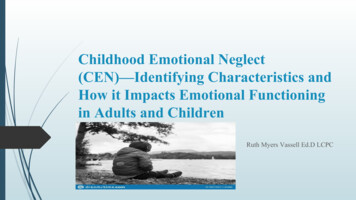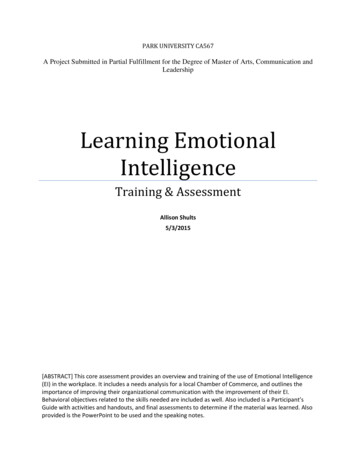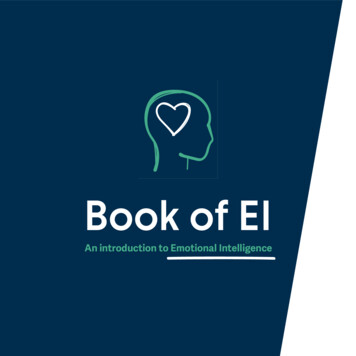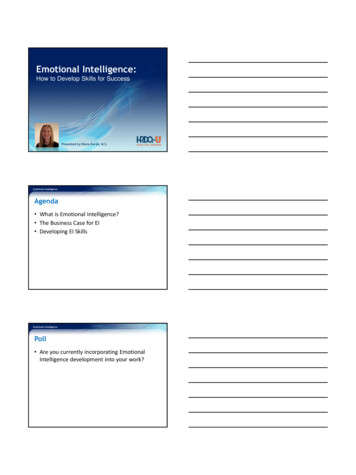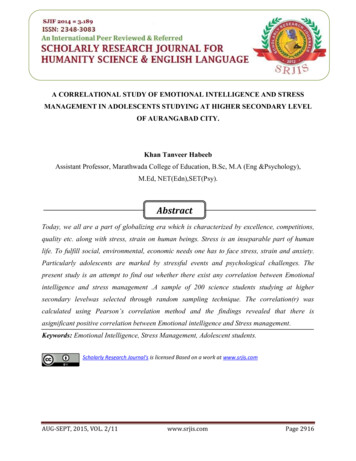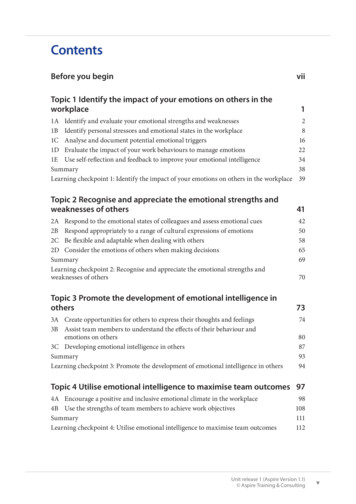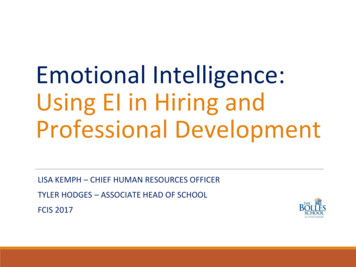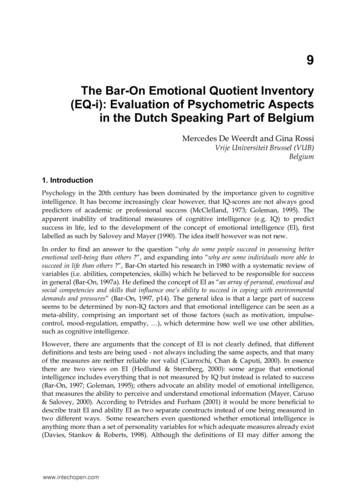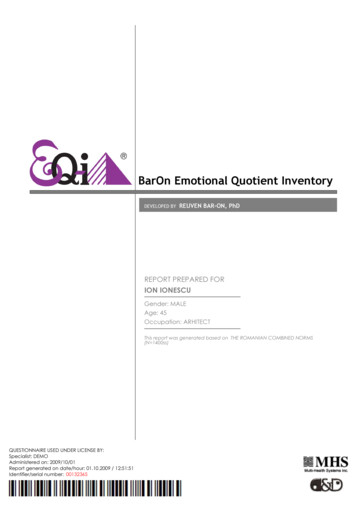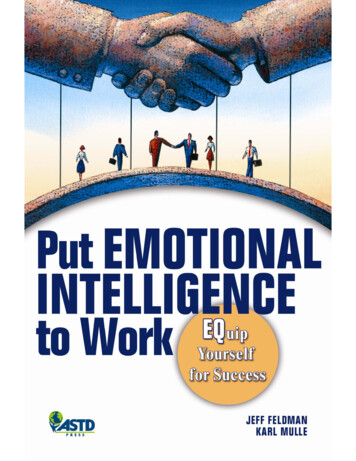
Transcription
Put EmotionalIntelligenceto WorkEQuip Yourself for SuccessJEFF FELDMANANDKARL MULLEAlexandria, Virginia
2007 the American Society for Training & DevelopmentAll rights reserved. Printed in the United States of America.No part of this publication may be reproduced, distributed, or transmitted inany form or by any means, including photocopying, recording, or otherelectronic or mechanical methods, without the prior written permission of thepublisher, except in the case of brief quotations embodied in critical reviewsand certain other noncommercial uses permitted by copyright law. Forpermission requests, please go to www.copyright.com, or contact CopyrightClearance Center (CCC), 222 Rosewood Drive, Danvers, MA 01923(telephone: 978.750.8400, fax: 978.646.8600).ASTD Press is an internationally renowned source of insightful and practicalinformation on workplace learning and performance topics, including trainingbasics, evaluation and return-on-investment, instructional systemsdevelopment, e-learning, leadership, and career development.Ordering information for print edition: Books published by ASTDPress can be purchased by visiting ASTD’s website at store.astd.org orby calling 800.628.2783 or 703.683.8100.Library of Congress Control Number (print edition only): 2007921486Print edition ISBN: 978-1-56286-482-8PDF e-book edition ISBN: 978-1-60728-255-62009-1ASTD Press Editorial StaffDirector: Cat RussoManager, Acquisitions & Author Relations: Mark MorrowEditorial Manager: Jacqueline Edlund-BraunEditorial Assistant: Maureen SoyarsRetail Trade Manager: Yelba QuinnCover Design: Ana IlievaCover Illustration: Jonathan EvansEditing and production by IGS, Inc.
ContentsPrefacevChapter 1.Emotional Intelligence: The New Science ofSuccessChapter 2.Emotional Self-Awareness13Chapter 3.Confidence, Self-Esteem, and PeakPerformance25Chapter 4.Anatomy of an Emotion35Chapter 5.Cognitive and Behavioral Strategies forManaging Your Emotions51Chapter 6.Achieving Goals and Overcoming Adversity71Chapter 7.Social Awareness81Chapter 8.EI and Workplace Issuesiii1101
Chapter 9.Emotional Intelligence and Influence123Chapter 10.Putting It All Together—Your EI Plan ofAction141References149Emotional Intelligence Quick Assessment151Additional Resources155Index157About the Authors163iv
PrefaceThirty-five people gathered in Room 10 that morning. The classroomwas designed to hold only 30 comfortably. We were at 3M, ourlargest corporate client at the time, one we had been serving for the pastseveral years with a training curriculum called Personal Leadership. Wewere launching a new course in the PL series and apparently it addresseda topic that was generating quite a bit of interest.This occurred in 1996, a year after Daniel Goleman had published hisnow landmark book, Emotional Intelligence: Why It Can Matter Morethan IQ. The book created a tremendous buzz in the business world;organizations everywhere were clamoring for more insight into this thingcalled emotional intelligence.From our first EI course that day at 3M through the work we’ve donepresenting this topic to Johnson & Johnson, General Electric, the U.S.government, and a host of other organizations large and small, the interestin and perceived value of emotional intelligence has not waned. Researchin the field has grown tremendously, various models have been developed,new questions have been raised, lines of thinking have diverged, and weall still have a lot to learn.Daniel Goleman didn’t invent emotional intelligence; rather, he verynicely packaged and built on some work done by others in the field.Psychologists Peter Salovey and John Mayer are often credited as havingcoined the term “emotional intelligence” in an article by the same namethey co-authored in 1990. Five years before that though, Reuven BarOn, a psychologist at Haifa University in Israel, was seeking to isolateand identify the factors that determine one’s ability to be effective inv
Prefacelife. Based on his research findings, Bar-On introduced something hecalled the emotional quotient or EQ. This abbreviation, of course, wasa pushback against the long-running notion that a high IQ was a predictorof success in life. Bar-On and many who have researched, written about,and taught the concepts of emotional intelligence after him believe thatalthough intellect is certainly important, intellectual capacity alone isnot enough. Other critical factors need to be considered. These factors,an interrelated group of competencies, are collectively known as emotional intelligence.Definitions and models for framing EI continue to be refined by boththe pioneers of the field and those who have followed in their footsteps.There are several different versions, and each camp likes to put on itsown spin. For our purposes here, we choose to apply a fairly generaldefinition to the term:Emotional intelligence is using your emotions intelligently to gain theperformance you wish to see within yourself and to achieve interpersonaleffectiveness with others.Our placement of the emotional intelligence competencies as a component of overall performance aligns us most closely with Daniel Goleman’sframework for EI. Goleman’s model consists of four major EI domains: Self-Awareness Self-Management Social Awareness Relational Skills.Within each of these domains, Goleman describes related competencies.You’ll find these domains and many of the competencies within eachdescribed in detail in the pages ahead.WHY WE WROTE THIS BOOKA number of important questions need to be asked about emotionalintelligence. Primary among them is: Can the competencies of emotionalintelligence be developed? IQ is often thought of as being static—youvi
Prefacescore what you score on the IQ test and that’s about where it staysthroughout your life. So what about growth opportunities for one’s EQ?Most researchers and practitioners in the field believe that emotionalintelligence is something that can be developed. We agree of course,thus we offer this book on the topic. Granted, some people may be morenaturally gifted at certain EI competencies than others, but competenciesconsist of behaviors that can be developmentally scaled. This means thatwith training and practice we can all become more competent over time.Therefore, we believe that all people have EI within them and candevelop their EI abilities more fully if desired.A second important question then follows—can EI be measured? Again,many of those in the field believe that it can be. Goleman, Bar-On, andSalovy and Mayer along with their colleague David Caruso have alldeveloped EI (or EQ in the case of Bar-On) assessment instruments.Some of these are self-scoring instruments requiring a high degree of selfinsight and honesty, whereas others are 360-feedback designs invitinginput from those with whom you work or otherwise interact. See theResources section of the book for an overview of some of the various EIassessment instruments.Today many individuals and organizations are doing good work in thefield of emotional intelligence research, promotion, and education. Wefeel that these efforts have significant value both for enhancing the livesof individuals and for contributing to organizational effectiveness. Weapplaud the work being done and are proud to be a small part of it. Weoffer this book to you as a launching-off point. Allow Put EmotionalIntelligence to Work to serve as your introduction to and overview of theconcept of emotional intelligence. We hope it provides valuable insight,presents pathways for growth, and provokes you to further explorationboth within yourself and ever deeper into the realm of emotional intelligence.HOW THIS BOOK WILL HELP YOUThe question: “What is emotional intelligence?” does not necessarily havea basic answer. We have suggested a simple definition, but in realityvii
Prefaceemotional intelligence works more like a construct, a comprehensivemodel that is used to understand how cognition and emotion affect bothpersonal and interpersonal behaviors. Put Emotional Intelligence to Worktherefore offers these tools: It concisely explains the EI model.It translates the current EI research into practical, relevant understanding.It focuses on the relevance of EI for personal and interpersonalsuccess.It offers practical application exercises.It teaches the reader how to manage impulsive, unpleasant, anddisruptive emotions that often lead to unwanted behaviors.It teaches the reader how to tap into self-motivating emotionslike confidence, passion, enthusiasm, desire, happiness, and anticipation.It demonstrates how emotional intelligence learning applies toinfluencing people, managing change, dealing with conflict,building teams, and developing others.It provides insight into what it means to be an emotionallyintelligent leader.WHO SHOULD READ THIS BOOK?We have written this book for people who want to develop their ownemotional competency and for training, learning, and development professionals who are committed to building emotionally intelligent organizations. This group might include: trainers who want to learn more about how to apply emotionalintelligence research to practical learning organization development professionals human resource professionals managers who need emotional intelligence training to enhanceleadership and coaching skillsviii
Preface anyone who wants to understand how the various componentsof emotional intelligence work together to form a comprehensivemodel of effective living anyone who wants to translate the current EI research into practical and relevant applications faculty members and school teachers who want to integrate emotional intelligence concepts into their teaching materials.CHAPTER-BY-CHAPTER HIGHLIGHTSAs trainers, we seek to create opportunities in the training classroom forparticipants to experience the content we are exploring together. Wework hard to take the theories of something like EI and bring them tolife through activities and exercises. Through these efforts, we seek toboth engage our training participants more deeply in the content as wellas to help them to build a bridge of relevancy between these theoriesand their real lives.Here now, as we seek to express EI in book form, we find ourselvesanother step removed from being able to truly bring this content to lifeand help you, the reader, make a connection to it. To resolve this, atpoints throughout the book, we lean back on our EI-training-classroomexperiences. Every so often in a chapter, you’ll come across somethingcalled “A Glimpse into the Classroom” in which we tell the story of howwe explore one aspect of EI in a training session. We include these littlevignettes as a way of helping you “experience” EI as we often present itin the training sessions, allowing you to live vicariously through theclassroom-based experience of our training participants. We hope youfind these glimpses both interesting and helpful.Our exploration of emotional intelligence begins with self-awareness.Research supports that self-awareness is foundational to both self-management and social awareness. Self-management and social awareness thendetermine relationship effectiveness. A summary of the chapter-by-chapter content follows. We begin with self-awareness, move on to selfmanagement, then consider social awareness, and relationship management.ix
PrefaceChapter 1. Emotional Intelligence: The New Science of SuccessThis chapter introduces the concept of emotional intelligence, examineswhy it is important to success, and explores EI basics.Chapter 2. Emotional Self-AwarenessThis chapter defines self-awareness as an effortful activity that includesnot only recognition of emotional states, but also an awareness of whythe emotion is present and an acceptance of the emotion as a source ofhelpful feedback.Chapter 3. Confidence, Self-Esteem, and Peak PerformanceA component of self-awareness includes an awareness of one’s personalstrengths, self-worth, capabilities, and even purpose in life. This chaptershows how your confidence and self-esteem are developed through ahealthy and accurate assessment of your true giftedness.If self-awareness provides us with accurate feedback, then self-management is our response to that feedback. Chapters 4, 5, and 6 focus onself-management.Chapter 4. The Anatomy of an EmotionThe first step to managing your emotions is to understand why emotionscan often be so impulsive, reactive, and disruptive. This chapter explainshow the brain processes emotions and that you have the ability to use yourunique human intelligence to manage disruptive emotions proactively.Chapter 5. Cognitive and Behavioral Strategies for ManagingYour EmotionsThis chapter explores both cognitive and behavioral strategies for managing disruptive emotions.Chapter 6. Achieving Goals and Overcoming AdversityPart of managing emotions includes learning how to tap into emotionalenergy and employ it in the direction of achieving goals. This chapterx
Prefacediscusses the kind of emotional energy that we all want to leverage—enthusiasm, motivation, passion, desire, and optimism.Chapters 7 to 10 move us from the personal competencies of self-awarenessand self-management to the social competencies of social awareness andrelationship management.Chapter 7. Social AwarenessPerhaps the most important skill to developing effective interpersonalrelationships is empathy. This chapter explains why empathy is soimportant, how to do it well, and how to avoid some common pitfallssurrounding it.Chapter 8. EI and Workplace IssuesRelationship management is where your self-awareness, self-management,and social awareness get put to the test. This chapter explains howemotional intelligence helps you deal with the potentially more emotionalchallenges of work life—navigating change, resolving conflict, and interacting with teams.Chapter 9. Emotional Intelligence and InfluenceInfluence is the result of a kind of emotional energy that occurs betweentwo or more people who resonate with one another. This chapter exploresthe concept of resonant leadership and how to create resonance in yourinterpersonal relationships.Chapter 10. Putting It All Together—Your EI Plan of ActionThis chapter provides a framework for clarifying your intentions concerning growth and development of your emotional intelligence and offers astructure for creating an action plan for implementing your development goals.In addition, the book includes an Additional Resources section that listsmany sources to support your further exploration and continued growthand development of your emotional intelligence.xi
PrefaceHOW THIS BOOK CAN HELP YOU TO EQUIP YOURSELFFOR SUCCESSEmotional intelligence is something we all have within us. We have nodoubt that you are already strong in certain aspects of EI. We also haveno doubt that there are elements of emotional intelligence that you needto be reminded of and in which you could focus some energy towardbecoming more secure. That’s what your journey through this book andthis work is all about. Our challenge to you as you turn these pages andengage this exploration is this: Recognize, acknowledge, and celebrate your strengths with regardto EI. Leverage these gifts to their fullest potential. Identify areas of EI in which you need to grow. Focus some energyon this by putting in place an action plan for development inthese areas.We need to add the disclaimer that when you’ve turned the last page ofthis text and set this book aside fully read, you will not necessarily bemore emotionally intelligent than you were when you began reading.Sorry, it just doesn’t work that way! Leveraging, honing, and improvingthe skills of EI requires practice and focused effort. It requires real-worldapplication and cannot be gained by simply reading “How to . . . ”We can promise that when you finish this book, you’ll know what EIlooks like, you’ll understand why it’s critical to your success in life. Youwill have some foundation for applying and growing it as needed. Atthat point, we’ll have done our job; the rest is up to you.ACKNOWLEDGMENTSWe dedicate this book to our spouses, Kristin Alexander, and JessicaMulle. Their support and encouragement gave us the emotional nourishment we needed to complete this book even when we both had toomany irons in the fire. We also thank our colleague and friend, BruceChristopher, who was in Room 10 with us when we first started thisjourney.xii
Chapter 1Emotional Intelligence:The New Science of Success.In this chapter, you will learn. why emotional intelligence is soimportant for success the definition and components of emotional intelligence the basic framework for discussing emotional intelligence in this book how this book can help you EQuip Yourself for success.Jimmy’s mom glanced at his report card and frowned. “Look at thesegrades! Do you realize that this is going into your permanent schoolrecord?” The dreaded parental warning played over and over again inJimmy’s 10-year-old mind. “Have I really just blown my opportunity tobe successful in life?” he wondered.Do you recall your school report cards? If you attended grammar schoolbefore the 1980s you likely would not have received quarterly progressupdates via the electronic, computer-generated version so familiar today.Certainly grades for each course were issued, but they were handwrittenin black, blue, or red ink. The long journey home from school even found1
Put Emotional Intelligence to Worksome youngsters frantically trying to find the right color ink, so that theC in Social Studies could be converted into a B, or possibly even an A.Of course the hope was to avoid whatever the inevitable punishmentwas going to be for achieving grades lower than expected. Unfortunately,these report cards contained something much more difficult for thesechildren to deal with, something that no one could change or avoid—theteacher’s comments scrawled in the margins of the report.Who knew then, that the most important predictor of young Jimmy’ssuccess had little to do with the grade itself, but was more a factor ofthose handwritten notes in the margin?Jimmy plays well with all the students and is the most popular boyin school. He is a natural leader. Unfortunately, he is using hispopularity to influence other children to stay late on the playgroundduring lunch, instead of coming to math class on time. His grade inmath has slipped to a “C.”If Jimmy was slightly more precocious and allowed to get away with it,he could turn to his parents and say, “Did you know that getting alongwell with others is a component of emotional intelligence, which researchshows is more important for success than my 4th grade math scores?”Unfortunately, Jimmy can’t quite pull that off, and his low grade in mathmay lead him to be grounded from playing with his friends for a few days.The truth is that the life skills Jimmy learns on the playground are justas important as his academic training in helping him to successfullyachieve his goals and get what he wants out of life. When Jimmy is olderand enters the workforce, he will discover that a basic level of technicalskill and academic achievement are necessary to get his “foot in thedoor.” He will realize that in some ways school never ends. All employeesare expected to develop expertise by learning and improving on the job.But beyond these basic, threshold requirements, the crucial skills that arenecessary for his achievement and success are all related to emotionalintelligence (Goleman, 1998): listening and oral communication adaptability and creative responses to setbacks and obstacles2
Emotional Intelligence: Science of Success personal management, confidence, motivation to worktoward goals, a sense of wanting to develop one’s careerand take pride in accomplishments group and interpersonal effectiveness, cooperation, andteamwork; ability to negotiate disagreements effectiveness in the organization, wanting to make a contribution, leadership potential.Daniel Goleman (1998), who has conducted studies in over 200 largecompanies, says: “The research shows that for jobs of all kinds, emotionalintelligence is twice as important an ingredient of outstanding performanceas ability and technical skill combined. The higher you go in the organization, the more important these qualities are for success. When it comesto leadership, they are almost everything.”Emotional intelligence then, is the x-factor that separates average performers from outstanding performers. It separates those who know themselveswell and take personal responsibility for their actions from those wholack self-awareness and repeat the same mistakes over and over. It separates those who can manage their emotions and motivate themselvesfrom those who are overwhelmed by their emotions and let their emotional impulses control their behaviors. It separates those who are goodat connecting with others and creating positive relationships from thosewho seem insensitive and uncaring. It separates those who build rapport,have influence, and collaborate effectively with others from those whoare demanding, lack empathy, and are therefore difficult to work with.Above all, emotional intelligence separates those who are successful atmanaging their emotional energy and navigating through life from thosewho find themselves in emotional wreckage, derailed, and sometimeseven disqualified from the path to success.EMOTIONAL INTELLIGENCE: THE DIFFERENCEBETWEEN SUCCESS AND DERAILMENTTwo stories will be presented. One ends successfully; the other does not.Both of these stories represent emotionally charged situations in which3
Put Emotional Intelligence to Workthe primary difference between one’s success and the other’s derailmentis emotional intelligence. In each situation, emotional arousal offers twopossible outcomes:Success Being aware of your emotions and managing them soyour behaviors are intelligently and proactively driven, resulting inintentional and successful outcomes.Derailment Losing control of your emotions so your behaviorsare impulsively and reactively driven, resulting in unintended andpotentially costly outcomes.A Success StorySarah was 22 years old and had somewhat limited business experience.She was now living on her own, so finding a job (and a source of income)was very important to her. After a series of four interviews for an insidesales and customer service position with a new company, she finally gotthe call that offered her the position. In her own words she describesthe experience:“I was very excited! This was a new industry in an area of computertechnology I was unfamiliar with. It would be an exciting new challenge.Five days before my official start date, I unexpectedly received a planeticket in the mail from the CEO of the company. I contacted him andasked what it was regarding and was told he would like me to go toWashington, D.C., and assist him with selling the company’s computersoftware at a major tradeshow.“Initially, I was taken aback with the proposition. I had never met theCEO. I hadn’t yet set foot in the office to do even a minute of training.I had no idea how to sell software I had never seen . . . much less fly toD.C. and sell it there!“I was nervous. My emotions were telling me to figure out some way toavoid this trip. My gut feeling, however, told me that my decision to goon this trip as requested would set the tone for the rest of my career withthis company. It would also establish the CEO’s perception of me. Despite4
Emotional Intelligence: Science of Successfeeling scared and quite unprepared for this role, I determined to makethe best of it and told the CEO I would be happy to assist him.“I only had four days to get ready and did not even own a decent businesssuit. I was on a very limited budget, so I went to a thrift shop to lookfor an appropriate business outfit. I found the perfect suit. Then I wentto the dollar store and found some fake jewelry that looked real enough.I put it all together and managed to look very professional for less than 15.“When the big day arrived, I flew to D.C. Taking my first taxi ever, Iheaded downtown to one of the most upscale hotels in Washington.Feeling way out of my league, I checked in and called the CEO to lethim know I had arrived. We met at a restaurant in the lobby of thehotel. He was tall and dressed perfectly. My impression was that he sethigh standards for how he expected others to look. He was professional,friendly, and extremely intelligent. I could tell immediately that he hada low tolerance for incompetence.“We had a nice dinner meeting, but he offered little in the way of trainingor information about what I was expected to do. As our dinner ended,he handed me a folder that contained information about the products Iwould be selling the next morning. It was 11 p.m. I was exhausted andhad to go right to bed without time to look over the materials.“The show started at 7:30 a.m. and I was up at 5 a.m. to give myselfenough time to get ready. With little time to spare, I propped up thepapers he gave me in front of the bathroom mirror and managed to studythe materials while blow-drying my hair! I did the best I could to learnabout the software and its features, compatibility issues, technical supportsolutions, and other details. I relieved some of my nervousness byreminding myself that the CEO would be there to work with me.“When we met in the tradeshow hall, there were several thousand professionals ready to ask us questions. As it turned out, there would be no“us.” The CEO said I would have to run the show on my own becausehe had to attend meetings all day. In that moment, I actually wanted tocry! I had no idea what I was doing, and these people all wanted answers.5
Put Emotional Intelligence to Work“By about mid-morning, I began to feel more confident. My crash coursewith hairdryer in hand turned out to be very helpful. Most of the tradeshowattendees showed understanding if I didn’t have an exact answer to theirquestions, and accepted my offer to follow-up with them later.“At the end of the day when my new boss came back, I was full of smiles.I was proud of myself for all of the accomplishments—arriving, quicklylearning the job, and actually selling some software! He inquired, “Howdid it go?” “Excellent,” I replied. “I did great and we made a lot of money!”His face lit up and he was eager to hear the details. I told him that Isold a 200 piece of software. His face formed a funny smile, the waya parent smiles when a child does something wrong but is too cuteto reprimand.“Now, 10 years later with the same company, I know that 200 for a dayis a terrible show. The goal is about 5,000 a day. But in my blissfullyignorant excitement, the CEO was too nice to burst my bubble. It wasthe foundation for a wonderful 10 years at his company. I am now Directorof Operations and oversee a multimillion-dollar business.“I learned many lessons from that experience in Washington, D.C. Perhaps the most important being that no matter who you are, stretchingoutside your comfort zone is a formula for success and confidence. Evenif I had failed (which in terms of sales numbers I did), I would alwaysbe proud that I got on the plane and with a positive, optimistic attitudetried my best! Doing so then and since has ultimately led to a level ofachievement I had only imagined.”A Derailment StoryRon Artest Jr. was born and raised in the largest public housing development in the United States, the Queensbridge Projects of Long IslandCity, New York. His success in basketball provided him with his ticketout of the projects. After becoming an NCAA All-American in 1999,he joined the professional ranks, and by 2004, was considered one of thebest defensive players in the National Basketball Association. In fact, he6
Emotional Intelligence: Science of Successwas voted the NBA’s Defensive Player of the Year for the 2003-2004basketball season. Unfortunately for Artest, his on-court success has oftenbeen be overshadowed by his reputation for having a short fuse.On November 19, 2004, Artest took center stage in arguably the mostinfamous brawl in professional sports history. With less than a minuteleft in the game, Artest’s Indianapolis Pacers were well on their way tovictory with an insurmountable 97-82 lead over the Detroit Pistons.The brawl began when Artest fouled Piston’s Ben Wallace. A frustratedWallace, upset at being fouled so hard when the game was effectivelyover, responded by shoving Artest hard with both hands, accidentallyhitting him in the nose. A number of Pacers and Pistons squared off, butArtest actually walked away from the fracas and lay on the scorer’s tablein order to calm himself down. At this point cooler heads could haveprevailed, but Wallace continued to instigate. He walked over to thescorer’s table and threw his armband at Artest. One of the Piston’s fansfollowed suit by throwing a cup full of ice and liquid that hit Artest onthe chest and in the face.One could argue that Artest was provoked. In his own words, Artest said:“I . . . was lying down when I got hit with a liquid, ice and glass containeron my chest and on my face. After that it was self defense.” In selfdefense mode, Artest snapped to attention and jumped into the frontrow seats, confronting the man he believed to be responsible. But in thechaos of the moment, he actually confronted the wrong man. The situation quickly erupted into a brawl between Piston’s fans and several ofthe Indiana Pacer players. Artest returned to the basketball court, wherehe managed to deck a Piston’s fan, who apparently was taunting him.The mayhem ended with Detroit fans throwing chairs, food, and otherdebris at the Indianapolis players while they walked back to theirlocker room.In the aftermath, each participant c
Put Emotional Intelligence to Work. to serve as your introduction to and overview of the concept of emotional intelligence. We hope it provides valuable insight, presents pathways for growth, and provokes you to further exploration both within yourself and ever deeper into the realm of emotional intelli-gence. HOW THIS BOOK WILL HELP YOU. The .
